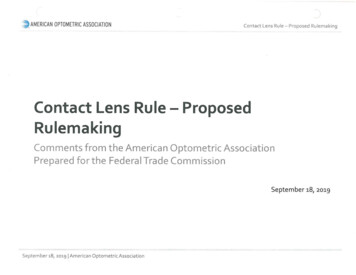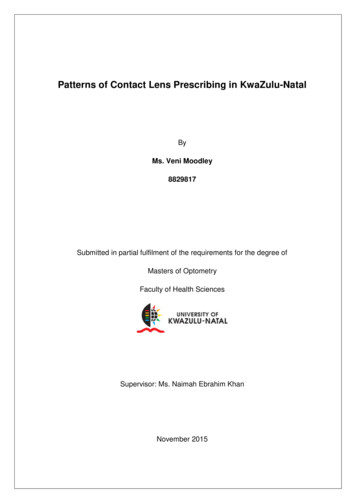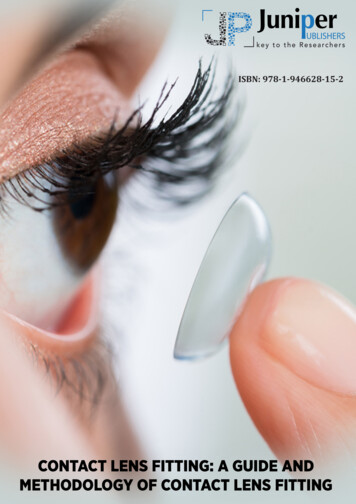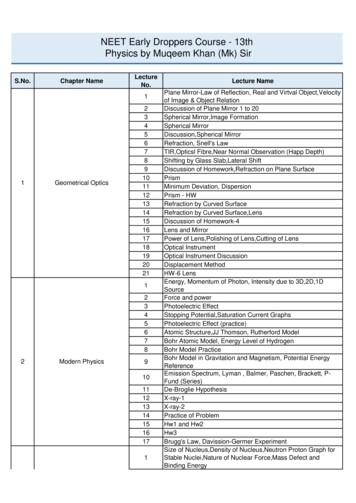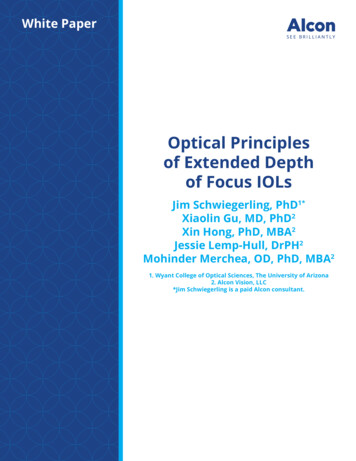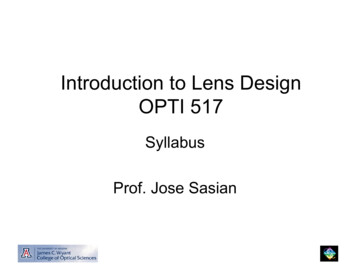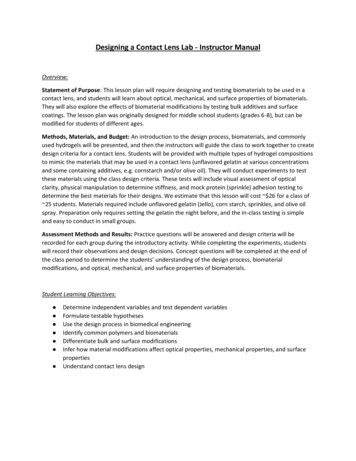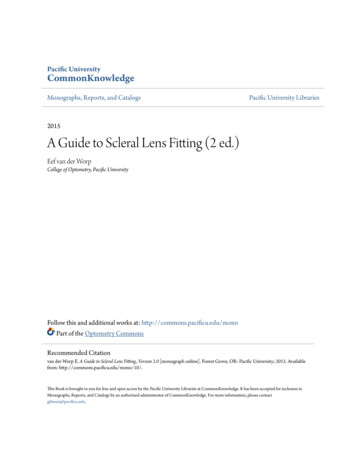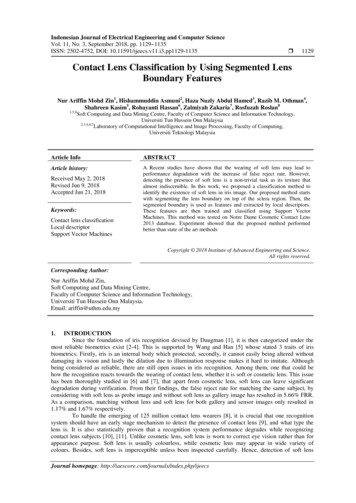
Transcription
Indonesian Journal of Electrical Engineering and Computer ScienceVol. 11, No. 3, September 2018, pp. 1129 1135ISSN: 2502-4752, DOI: 10.11591/ijeecs.v11.i3.pp1129-1135 1129Contact Lens Classification by Using Segmented LensBoundary FeaturesNur Ariffin Mohd Zin1, Hishammuddin Asmuni2, Haza Nuzly Abdul Hamed3, Razib M. Othman4,Shahreen Kasim5, Rohayanti Hassan6, Zalmiyah Zakaria7, Rosfuzah Roslan81,5,8Soft Computing and Data Mining Centre, Faculty of Computer Science and Information Technology,Universiti Tun Hussein Onn Malaysia2,3,4,6,7Laboratory of Computational Intelligence and Image Processing, Faculty of Computing,Universiti Teknologi MalaysiaArticle InfoABSTRACTArticle history:A Recent studies have shown that the wearing of soft lens may lead toperformance degradation with the increase of false reject rate. However,detecting the presence of soft lens is a non-trivial task as its texture thatalmost indiscernible. In this work, we proposed a classification method toidentify the existence of soft lens in iris image. Our proposed method startswith segmenting the lens boundary on top of the sclera region. Then, thesegmented boundary is used as features and extracted by local descriptors.These features are then trained and classified using Support VectorMachines. This method was tested on Notre Dame Cosmetic Contact Lens2013 database. Experiment showed that the proposed method performedbetter than state of the art methodsReceived May 2, 2018Revised Jun 9, 2018Accepted Jun 21, 2018Keywords:Contact lens classificationLocal descriptorSupport Vector MachinesCopyright 2018 Institute of Advanced Engineering and Science.All rights reserved.Corresponding Author:Nur Ariffin Mohd Zin,Soft Computing and Data Mining Centre,Faculty of Computer Science and Information Technology,Universiti Tun Hussein Onn Malaysia.Email: ariffin@uthm.edu.my1.INTRODUCTIONSince the foundation of iris recognition devised by Daugman [1], it is then categorized under themost reliable biometrics exist [2-4]. This is supported by Wang and Han [5] whose stated 3 traits of irisbiometrics; Firstly, iris is an internal body which protected, secondly, it cannot easily being altered withoutdamaging its vision and lastly the dilation due to illumination response makes it hard to imitate. Althoughbeing considered as reliable, there are still open issues in iris recognition. Among them, one that could behow the recognition reacts towards the wearing of contact lens, whether it is soft or cosmetic lens. This issuehas been thoroughly studied in [6] and [7], that apart from cosmetic lens, soft lens can leave significantdegradation during verification. From their findings, the false reject rate for matching the same subject, byconsidering with soft lens as probe image and without soft lens as gallery image has resulted in 5.66% FRR.As a comparison, matching without lens and soft lens for both gallery and sensor images only resulted in1.17% and 1.67% respectively.To handle the emerging of 125 million contact lens wearers [8], it is crucial that one recognitionsystem should have an early stage mechanism to detect the presence of contact lens [9], and what type thelens is. It is also statistically proven that a recognition system performance degrades while recognizingcontact lens subjects [10], [11]. Unlike cosmetic lens, soft lens is worn to correct eye vision rather than forappearance purpose. Soft lens is usually colourless, while cosmetic lens may appear in wide variety ofcolours. Besides, soft lens is imperceptible unless been inspected carefully. Hence, detection of soft lensJournal homepage: http://iaescore.com/journals/index.php/ijeecs
1130 ISSN: 2502-4752would be a non-trivial task that requires a mathematical and statistical approach to automating the task. Thepresence of soft lens can be noticed for one distinct feature, which is the lens boundary located on top of thesclera region. We may assume this boundary can be easily detected, however, it comprises of very thin lineand can be easily confused by noise resulted from inconsistent illumination. In this work, we take thechallenge to segment the lens boundary and use it as features, then, train it using Support Vector Machine, inorder to classify between with or without soft lens. The novelty of our work is the fusion of extracted featuresproduces from two prominent descriptors, Histogram of Gradient (HOG) and Scale Invariant FeatureTransform (SIFT). The details of our work are represented in the following sections. In Section 2, anyprevious works regarding contact lens detection are discussed. In Section 3, our proposed method isdescribed in details. The experimental results and discussions are reported in Section 4 and lastly, Section 5draws the conclusion.2.RELATED WORKSDuring decades, cosmetic lens has gained a lot of attention in iris recognition community. A lot ofresearch has been conducted extensively mainly under the subject of fake iris detection and iris spoofing. Itwas pioneered by Daugman [12] who managed to detect dot matrix cosmetic lens using Fourier transform.Then, Lee et al. [13] introduced the use of Purkinje image to detect fake iris. The research continues whereHe et al. [12] utilized gray-level co-occurrence matrix (GLCM) as feature descriptor and SVM as classifier.They reported 100% accuracy tested on self-database. Meanwhile, Wei et al. [15] proposed three methods forcontact lens detection; iris edge sharpness, iris-textons and GLCM with SVM. Evaluation is done by usingCASIA and BATH database with accuracy achieved above 76.8%. Zhang et al. [16] used SIFT-weightedLocal Binary Pattern with SVM as classifier. They achieved 99% accuracy using self-database. Unlikecosmetic lens, soft lens has gained less attention in the community. This is due to the believe that soft lenswearing does not cause significant impact of degradation during wearing as supported in [17-19]. However,the awareness of the soft lens’s wearing impact in [6], [20] has ignited more researches being conducted.There are three approaches to soft lens detection, whether it is hardware, machine learning or imagesegmentation approach. Hardware approach requires the use of sophisticated camera. Such examples arefrom Kywe et al. [21] where they used a thermal camera to measure the decrement of temperature on the eyesurface during the blinking of the eye. They observed that a certain degree of decrement indicates thewearing of soft lens. Another work by Lee et al. [22] claimed that Purkinje images between original and lensworn iris are difference. These images are captured using two collimated IR-LED cameras. Recent work byHughes and Bowyer [23] detect the presence of lens by using stereo vision from two cameras. Soft lenswearing is detected if the captured image seen as curved surface rather than flat (without lens).Meanwhile, machine learning requires features descriptor and classifier to perform. Doyle et al. [9]used a modified Local Binary Pattern (LBP) as features descriptor and experimented with 14 differentclassifiers. They achieved 96.5% of correct classification for cosmetic lens. However, only 50.25% correctclassification for soft lens. Kohli et al. in [24] experimented with four methods; iris edge sharpness, texturalfeatures based on co-occurrence matrix, gray level co-occurrence matrix and LBP with SVM. They reportedthat LBP with SVM has inferred the best result in overall. However, only 54.8% CCR achieved for soft lens.Later, Yadav et al. [7] extend the work in [9] and [24] with additional database and revised algorithm. Theyachieved CCR above 45.35%. Gragnaniello et al. in [25], [26] used sclera and iris region as features andapplied Scale Invariant Descriptor as feature descriptor with SVM as classifier. They reported CCR above76.29%. Raghavendra et al. [27] proposed the use of Binarized Statistical Image Features (BSIF) with SVM.They achieved 62% for intra-sensor and 54% accuracy for inter-sensor. Silva et al. [29] used ConvolutionalNeural Network. They resulted in 65% for intra-sensor and 42.25% for inter-sensor.On the other hand, image segmentation approach uses edge detection technique to segment the thinlens boundary located on top of the sclera region. As to date, Erdogan and Ross [29] are the pioneer toimplement this approach. They proposed a clustering based edge detection to segment the outer lensboundary which has achieved an accuracy of 70%. From the literature, it can be summarized that thehardware approach relies on the physical characteristic of the eye. Machine learning approach insteadinvolves the discrimination between two templates [30] while image segmentation deals with pixelsmanipulation.3.PROPOSED METHODIn this work, we proposed a fusion of image segmentation and machine learning approach to classifytwo class problems of validating the presence of with or without soft lens. These approaches are chosen asmachine learning has the ability to extract and learn from training data to infer decision for a new data as wellIndonesian J Elec Eng & Comp Sci, Vol. 11, No. 3, September 2018 : 1129 – 1135
Indonesian J Elec Eng & Comp SciISSN: 2502-4752 1131as image segmentation approach that robust to lens type and sensors. Careful inspection shows that thewearing of soft lens will leave an obscure or darker edge line on top of the sclera region as shown inFigure 1. It has been thoroughly studied in [25] that the sclera region define the best sample to prove thepresence of soft lens. Therefore, our focus is to extract information on this region by locating the pixels oflens boundary and transform it into feature space by mean of a feature descriptor. These features are then tobe trained by a statistical learning approach in order to be classified. The next sub-section presents the mainthree stages of the proposed method which are segmentation, features extraction and classification. The stepby step processes of this method is depicted in Figure 2.Soft lens boundaryFigure 1. Examples of soft lens boundary location as pointed by arrow3.1 SegmentationIn the segmentation stage, the main objective is to locate the soft lens boundary which is deemed toreside on top of the sclera. It starts with segmentation of the left and right sclera region. We used the radiusinformation provided with Notre Dame Cosmetic Contact Lens 2013 (NDCCL13) [31] to segment the irisboundary by the mean of Circular Hough Transform. Then, we extend the iris radius with additional 30pixels to include the sclera region concentrically. The right-side region is segmented between the upper valueof 150 to lower value of 210 degree rotation and 30 to -30 degree rotation respectively at the left-side.Therefore, the segmentation process will produce two segmented images of left and right sclera. Theseimages are then to be normalized to ensure equal dimension for every iteration. In this case, we appliedDaugman’s rubber sheet normalization method [1]. The normalized images will have the size of 30 240pixels. All these steps are illustrated in Figure 3. Next, any presence of eyelash is removed using inpaintingalgorithm [32]. This is done by replacing the eyelash pixels with the mean of surrounding pixels. Weobserved that either one of the left or right normalized image will have a slightly brighter or darker lensboundary. This is due to the inconsistent illumination caused by poor flash lighting throughout the enrollmentprocess. In order to overcome this, we proposed a method called summed-histogram, where the frequenciesfor each pixel’s intensity value in the whole image is summed. Whenever the sum value is greater, thenormalized image is considered to have brighter lens boundary compared to the other. The summedhistogram of individual normalized image, is represented as follows: (Eq.1)Where is the summed-histogram of normalized image and is the pixel’s intensity in the correspondingnormalised polar coordinates.The value of will be the preliminary input for the next segmentationprocess. In this process, the ridge detection algorithm is employed to segment the lens boundary on thenormalized image. Among others segmentation algorithm, ridge detection has the ability to detect edge whilesharing the same background colour but differ in intensities, which resembles the lens boundary [33]. Theoutput from the ridge detection algorithm is the segmented lens boundary in a form of binary image wherelens boundary will be regarded as white (1) and the background as black (0). For without soft lens images, ablank image of black coloured will be generated.Contact Lens Classification by Using Segmented Lens Boundary Features (Nur Ariffin Mohd Zin)
1132 ISSN: 2502-4752Figure 2. The proposed two-class contact lens classification processFigure 3. The sclera segmentation and image normalization process3.2 Feature ExtractionUnder feature extraction stage, two input images are required; segmented lens boundary image andnormalized image of sclera region. The segmented lens boundary image is extracted using a window basedfeature descriptor; Histogram of Gradient [34]. HOG is chosen as the segmented lens boundary has theproperties of the edge orientation. By this mean, for every n n pixel in the image, the frequency histogramIndonesian J Elec Eng & Comp Sci, Vol. 11, No. 3, September 2018 : 1129 – 1135
Indonesian J Elec Eng & Comp SciISSN: 2502-4752 1133of edge orientation is computed. Then, the resulted edge orientation is quantized into b bins. In ourexperiment, n and b are set to 4 and 9 respectively. From our observation, the gradient of lens boundary isprone to appear in horizontal scale, which 170 to 190 degree rotation. Meanwhile, the normalized image ofthe sclera region is descripted using Scale Invariant Feature Transform (SIFT) [35]. The utilization of SIFT isto adapt the properties of having different scales, rotation and inhomogeneous shape of lens boundary,without degrading the performance of detection. There are four main steps of SIFT; scale-spacerepresentation, keypoints detection, keypoints orientation and generate keypoint descriptor. During scalespace representation, the Gaussian blurring is applied to the whole image with the number of octave is 4 andlevel per octave are set to 3.Then, Difference of Gaussian (DoG) of the blurred image is obtained bysubtracting subsequent scales in each octave, producing multiple image point of. By this mean, akeypoint is detected when its value is smaller (local minimum) or larger (local maximum) than thesurrounding point. Poorly localized points are excluded during keypoints detection. The next process is toassign an orientation to each keypoint by calculating its gradient directions and magnitudes in a region of 16 16. Finally, these regions are broken into sixteen 4 4 window and accumulates them into 8 bins histogramwith a weighted value of gradient magnitude. Therefore, there is 4 4 8 128 feature vectors for eachkeypoint. In this work, our interest is to use the description of edge orientation of HOG and the invarianceedge properties through SIFT to form a distinguishable feature of without and with soft lens. This is done byconcatenating both left and right features of HOG and SIFT for the respective iris image into a feature vector.3.3 ClassificationThe concatenated features are trained using a non-linear SVM with radius basis function kernel. 10fold cross validation were utilized to obtain the fittest parameters ofand gamma in order to reduceoverfitting. In order to classify between without or with soft lens, the images of without lens are also appliedto the whole process from segmentation to feature extraction. Images with prior knowledge of soft lenspresence will be labelled as positive samples and without lens images as negative samples.4.RESULTS AND ANALYSISIn this work, the iris images are retrieved from Notre Dame Cosmetic Contact Lens 2013(NDCCL13) [31] that contains grayscale iris images of without lens, with soft lens and with cosmetic lens.All images are captured using either LG4000 or AD100 NIR camera. For LG4000, all images are split into3000 for training and 1200 for testing while for AD100, 600 images are for training and 300 for testing.Table 1 shows the images distribution for NDCCL13 database.Table 1. NDCCL13 images class 00Testing400400400100100100All experiments are executed using Matlab R2017b on a machine with 2.3GHz and 6GB memory.We calculated confusion matrix for each class of different cameras. For uniformity with [7], we only reportedcorrect classification rate (CCR) with its average. However, the evaluation of cosmetic lens in not within ourscope as this work only focusing on two class classification of with or without soft lens. We annotated theclass of without lens as N and soft lens as S. N-N refers to the probability of without lens samples areclassified belongs to without lens while S-S refers to the probability of soft lens samples are classifiedbelongs to soft lens. Comparisons are made with existing methods proposed in [7] by using classical LBP,[36] by using a modified version of LBP, [28] by using Convolutional Neural Network, [27] by usingBinarized Statistical Image Features and [25] by using Scale Invariant Descriptor. During segmentationstage, each iris image will produce two segmented lens boundary images and two normalized images whichderived from the left and right sclera. These images are used for training and testing throughout theclassification stage. These samples of images are shown in Table 2. Therefore, for LG4000, there are 2000training images for without lens and another 2000 for soft lens. Meanwhile, for AD100, both without lensand soft lens constitute 400 training images each. The numbers of testing images are doubled up, the samemanner as training images.Contact Lens Classification by Using Segmented Lens Boundary Features (Nur Ariffin Mohd Zin)
1134ISSN: 2502-4752Table 2. NDCCL13 images class distributionImageScleraNormalized imageSegmented lens boundaryLeft04261d1016RightLeft06008d58RightTable 3 reports the performance of the proposed method with the aforementioned state-of-the-artmethods. The best results are written in bold. In summary, the proposed method has yielded the highestaverage for both cameras. However, the LG4000’s CCR for N-N classification has unable to surpass themethod from [25]. In the meantime, the CCR for S-S classification resulted over 10 points from the nearestfigure. It is observed that the results for AD100 are very marginal to achieve significant performance. Webelieve the less number of subjects is not sufficient to statistically generalize the variability between classes.Some of future works [37, 38] may be added for better performance in this research.Table 3. The correct classification rate and average of the proposed and state of the art methodsCamerasLG4000AD100ClassificationLBP 4.0048LBP PHOG[7]81.2565.4173.3342.0060.0051mLBP [7][36]85.5045.2565.3881.0052.0066.5CNN [28]BSIF IONThis work proposed two class contact lens classification of with or without soft lens. In order todistinguish between these classes, we focused on extracting local information available on the sclera region.It is observed that the wearing of soft lens may leave thin lines which appear to be the lens boundary.Therefore, we proposed a segmentation mechanism to segment this boundary and utilize Histogram ofGradient to extract the gradient orientation of the boundary. We also descript the original sclera region withScale Invariant Feature Transform in order to tackle the inhomogeneous shape and rotation of the lensboundary. These features are concatenated before trained and classified using a non-linear SVM. Resultsshowed that the proposed method achieved the highest average accuracy compared to other state-of-the-artmethods.ACKNOWLEDGEMENTThis work has been funded by Universiti Teknologi Malaysia and Ministry of Higher EducationMalaysia under FRGS Vot No: 4F973.REFERENCES[1][2][3][4][5][6]Daugman JG. Biometric Personal Identification System based on Iris Analysis. Google Patents. 1994.Dhavale SV. Robust Iris Recognition based on Statistical Properties of Walsh Hadamard Transform Domain. IJCSIInternational Journal of Computer Science Issues. 2012; 9(2).Hosseini MS, Araabi BN, and Soltanian-Zadeh H. Pigment Melanin: Pattern for Iris Recognition, IEEETransactions on Instrumentation and Measurement. 2010; 59(4): 792-804.Sim HM, Hishammuddinn A, Hassan R, Othman RM. Multimodal Biometrics: Weighted score level fusion basedon non-ideal iris and face images. Expert Systems with Applications. 2014; 41(11): 5390-5404.Wang Y, Han J. Iris Recognition using Support Vector Machines. International Symposium on Neural Networks.2004; 3173; 622-628.Baker SE, Hentz A, Bowyer KW, Flynn PJ. Degradation of Iris Recognition Performance due to Non-CosmeticPrescription Contact Lenses. Computer Vision and Image Understanding. 2010; 114(9): 1030-1044.Indonesian J Elec Eng & Comp Sci, Vol. 11, No. 3, September 2018 : 1129 – 1135
Indonesian J Elec Eng & Comp [32][33][34][35][36]ISSN: 2502-4752 1135Yadav D, Kohli N, Doyle JS, Singh R, Vatsa M, Bowyer KW. Unraveling the Effect of Textured Contact Lenseson Iris Recognition. IEEE Transactions on Information Forensics and Security. 2014; 9(5): 851-862.Kalsoom S, Ziauddin S. Iris Recognition: Existing Methods and Open Issues. The Fourth International Conferenceson Pervasive Patterns and Applications. 2012: 23-28.Doyle JS, Flynn PJ, Bowyer KW. Automated Classification of Contact Lens Type in Iris Images, 2013International Conference on Biometrics (ICB). 2013.Lovish, Nigam A, Kumar B, Gupta P. Robust Contact Lens Detection using Local Phase Quantization and BinaryGabor Pattern. 16th International Conference Computer Analysis of Images and Patterns. 2015: 702-714.Kumar B, Nigam A, Gupta P. Fully Automated Soft Contact Lens Detection from NIR Iris Images. InternationalConference on Pattern Recognition Applications and Methods. 2016: 589-596.Daugman J. Demodulation by Complex-Valued Wavelets for Stochastic Pattern Recognition. International Journalof Wavelets, Multiresolution and Information Processing. 2003: 1(01); 1-17.Lee EC, Park KR, Kim J. Fake Iris Detection by Using Purkinje Image. International Conference on Biometrics.2006: 397-403.He X, An S, Shi P. Statistical Texture Analysis-based Approach for Fake Iris Detection using Support VectorMachines. International Conference on Biometrics. 2007: 540-546.Wei Z, Qiu X, Sun Z, Tan T. Counterfeit Iris Detection based on Texture Analysis. 19th International Conferenceon Pattern Recognition. 2008.Zhang H, Sun Z, Tan T. Contact Lens Detection based on Weighted LBP. 20th International Conference on.Pattern Recognition (ICPR). 2010.Williams GO. Iris Recognition Technology. 30th Annual International Carnahan Conference. 1996.Negin M, Chmielewski TA, Salganicoff M, von Seelen UM, Venetainer PL, Zhang GG. An Iris Biometric Systemfor Public and Personal Use. Computer. 2000: 33(2); 70-75.Ali JM, Hassanien AE. An Iris Recognition System to Enhance e-Security Environment based on Wavelet Theory.Advanced Modeling and Optimization. 2003: 5(2); 93-104.Baker SE, Hentz A, Bowyer KW, Flynn PJ. Contact Lenses: Handle with Care for Iris Recognition. 2009 IEEE 3rdInternational Conference on Biometrics: Theory, Applications and Systems. 2009: 190-197.Kywe W, Yoshida M, Murakami K. Contact Lens Extraction by Using Thermo-Vision. 18th InternationalConference on Pattern Recognition. 2006.Lee EC, Park KR, Kim J. Fake Iris Detection by using Purkinje Image. Advances in Biometrics. 2005: 397-403.Hughes K, Bowyer KW. Detection of Contact Lens-based Iris Biometric Spoofs using Stereo Imaging. 46th HawaiiInternational Conference on System Sciences (HICSS). 2013.Kohli N, Daksha Y, Vatsa M, Singh R. Revisiting Iris Recognition with Color Cosmetic Contact Lenses.International Conference on Biometrics. 2013: 1-5.Gragnaniello D, Poggi G, Sansone C, Verdoliva L. Contact Lens Detection and Classification in Iris Imagesthrough Scale Invariant Descriptor. 10th International Conference on Signal-Image Technology and InternetBased Systems. 2014: 560-565.Gragnaniello D, Poggi G, Sansone C, Verdoliva L. Using Iris and Sclera for Detection and Classification ofContact Lenses. Pattern Recognition Letters. 2016: 82(2); 251-257.Raghavendra R, Raja KB, Busch C. Ensemble of Statistically Independent Filters for Robust Contact LensDetection in Iris Images. Indian Conference on Computer Vision Graphics and Image Processing. 2014.Silva P, Luz E, Baeta R, Pedrini H, Falcao AX, Menotti D. An Approach to Iris Contact Lens Detection based onDeep Image Representations. 28th SIBGRAPI Conference on Graphics, Patterns and Images. 2015: 157-164.Erdogan G, Ross A. Automatic Detection of Non-Cosmetic Soft Contact Lenses in Ocular Images. Biometric andSurveillance Technology for Human and Activity Identification X, 2013: 8712.He Z, Sun Z, Tan T, Wei Z. Efficient Iris Spoof Detection via Boosted Local Binary Patterns. InternationalConference on Biometrics. 2009: 1080-1090.Doyle J, Bowyer K. Notre Dame Image Database for Contact Lens Detection In Iris Recognition-2013. 2014.Bertalmio M, Sapiro G, Caselles V, Ballester C. Image Inpainting. 27th annual conference on Computer Graphicsand Interactive Techniques. 2000: 417-424.Damon J. Properties of Ridges and Cores for Two-Dimensional Images, Journal of Mathematical Imaging andVision. 1999: 10(2); 163-174.Dalal N, Triggs B. Histograms of Oriented Gradients for Human Detection. IEEE Computer Society Conferenceon Computer Vision and Pattern Recognition. 2005: 1; 886-893.Lowe DG. Distinctive Image Features from Scale-Invariant Keypoints. International Journal of Computer Vision.2004: 60(2); 91-110.Doyle JS, Bowyer KW, Flynn PJ. Variation in Accuracy of Textured Contact Lens Detection based on Sensor andLens Pattern. IEEE Sixth International Conference on Biometrics: Theory, Applications and Systems. 2013: 1-7.[37] Gunawan, T. S., Solihin, N. S., Morshidi, M. A., & Kartiwi, M. (2017). Development of Efficient IrisIdentification Algorithm using Wavelet Packets for Smartphone Application. Indonesian Journal ofElectrical Engineering and Computer Science, 8(2).[38] Chen, D., & Qin, G. (2017). An Embedded Iris Image Acquisition Research. Indonesian Journal ofElectrical Engineering and Computer Science, 5(1), 90-98.Contact Lens Classification by Using Segmented Lens Boundary Features (Nur Ariffin Mohd Zin)
As a comparison, matching without lens and soft lens for both gallery and sensor images only resulted in 1.17% and 1.67% respectively. To handle the emerging of 125 million contact lens wearers [8], it is crucial that one recognition system should have an early stage mechanism to detect the presence of contact lens [9], and what type the lens is.
